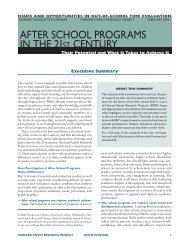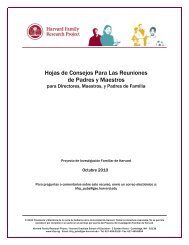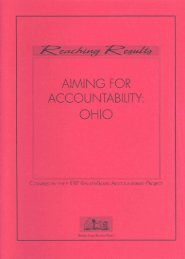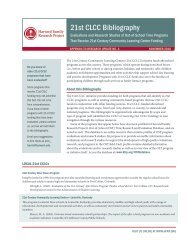Download a PDF of this case study - Harvard Family Research Project
Download a PDF of this case study - Harvard Family Research Project
Download a PDF of this case study - Harvard Family Research Project
Create successful ePaper yourself
Turn your PDF publications into a flip-book with our unique Google optimized e-Paper software.
The Network tailors its support to each member by providing individual technical<br />
assistance and tools to help schools individualize their planning. These tools include forms<br />
for a One-Year Action Plan, an agenda, and schedules (e.g., small group discussion<br />
guides, forms to schedule monthly activities to ease students' transitions to new schools,<br />
forms to link goals and practices with expected results). Using these tools, schools identify<br />
goals and appropriate partnership activities that will help them work toward those goals.<br />
The promising practices shared in trainings, on the website, and in the newsletter, <strong>of</strong>fer a<br />
wealth <strong>of</strong> examples <strong>of</strong> tailored activities that meet individual school interests, needs, and<br />
goals while addressing the different types <strong>of</strong> involvement laid out in the prescribed<br />
framework (see Appendix B for examples).<br />
Recent observations by Network staff indicate that some schools, especially those with<br />
high staff turnover, may need more guidance and structure than other schools. In<br />
response to <strong>this</strong>, the Network will work to make more step-by-step tools available. A recent<br />
Partnership Planner is a good example <strong>of</strong> <strong>this</strong>, providing an easy-to-follow checklist for<br />
programs. The next version <strong>of</strong> the handbook will be more directive to meet <strong>this</strong> emerging<br />
need.<br />
Prescribing a Team Structure<br />
Schools implement partnership programs through Action Teams. This is<br />
one <strong>of</strong> the central and prescribed components <strong>of</strong> partnership programs.<br />
Action teams should include at least two to three teachers from<br />
different grades, two to three parents with children in different<br />
grades, and one administrator. The Network recommends that a<br />
community member, two students in the upper grades, and other<br />
school personnel also are included. If a school council or other<br />
improvement team exists in the school, at least one member must also<br />
serve on that team (Epstein, Coates, Salinas, Sanders, & Simon, 1997).<br />
Over 90% <strong>of</strong> schools in the Network in the 1998-1999 year report having<br />
Action Teams for partnerships, and the others are working to form<br />
their Action Teams (Sanders 2000).<br />
This structure has been very effective in the areas <strong>of</strong> program<br />
implementation, quality, and continuity. Specifically, supportiveness <strong>of</strong><br />
the Action Team toward the program is one <strong>of</strong> two variables (along<br />
with the adequacy <strong>of</strong> funding) that predicts schools’ successful<br />
implementation <strong>of</strong> partnership programs. Successful implementation is<br />
defined as writing an action plan, implementing all six types <strong>of</strong><br />
partnership activities, meeting regularly, and evaluating program<br />
effectiveness (Sanders, 1998). Action Team support also predicts the<br />
self-reported quality <strong>of</strong> partnership programs (Sanders, 1998; Sanders,<br />
1999).<br />
Action Teams also serve the important function <strong>of</strong> maintaining<br />
leadership continuity in schools. The Network has continually faced and<br />
come to accept the challenge <strong>of</strong> high staff turnover in schools and<br />
districts. As Joyce Epstein explains, “change is inevitable,” but the<br />
Network has also responded to these transitions through program<br />
adaptations. The Action Team approach, which replaced a lone<br />
“project director” in pilots <strong>of</strong> the Network model, <strong>of</strong>fers increased<br />
sustainability for programs.<br />
- 10 -














